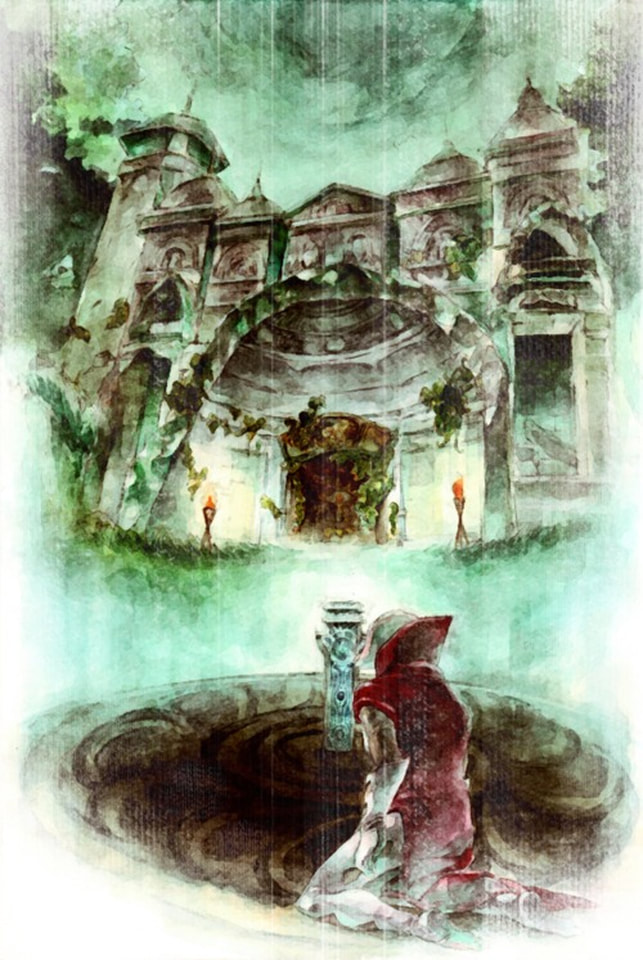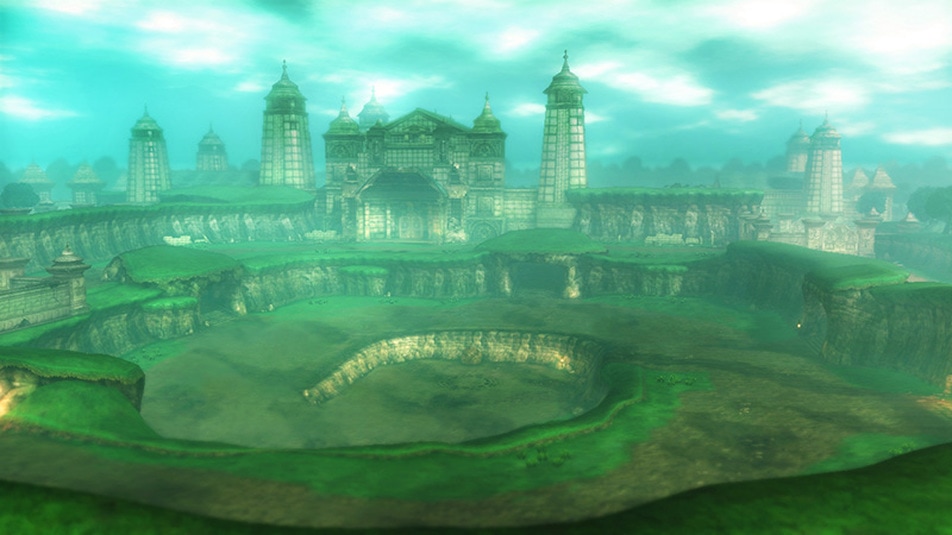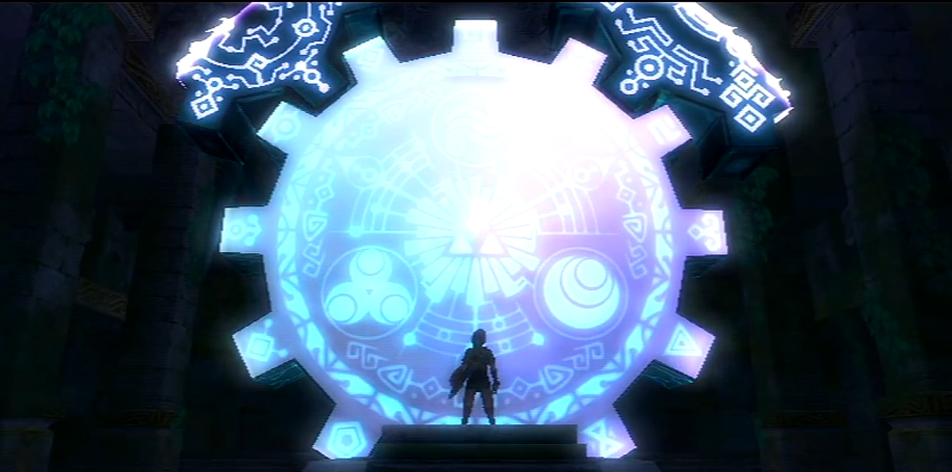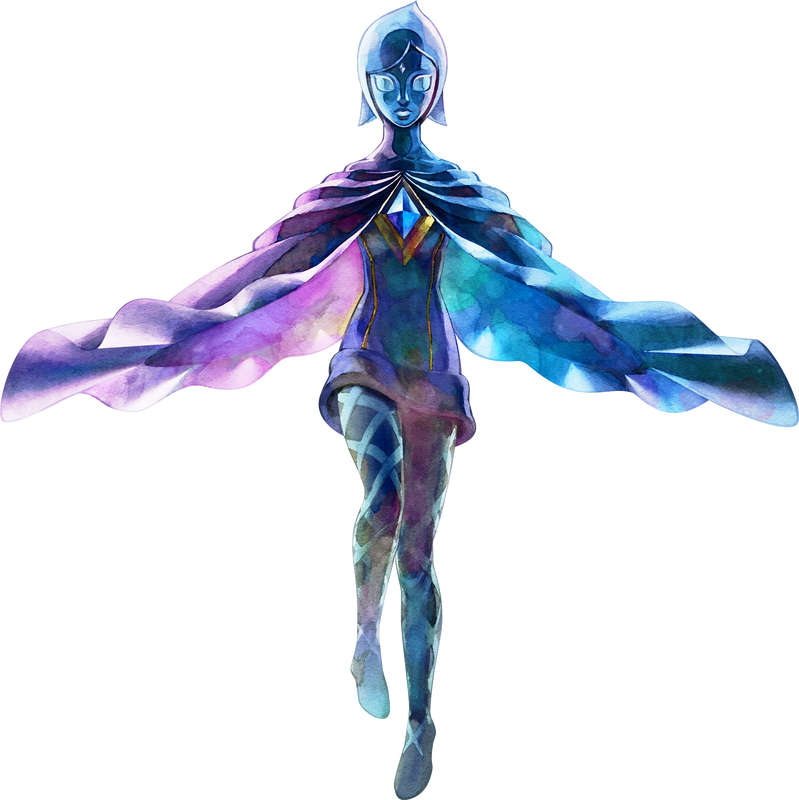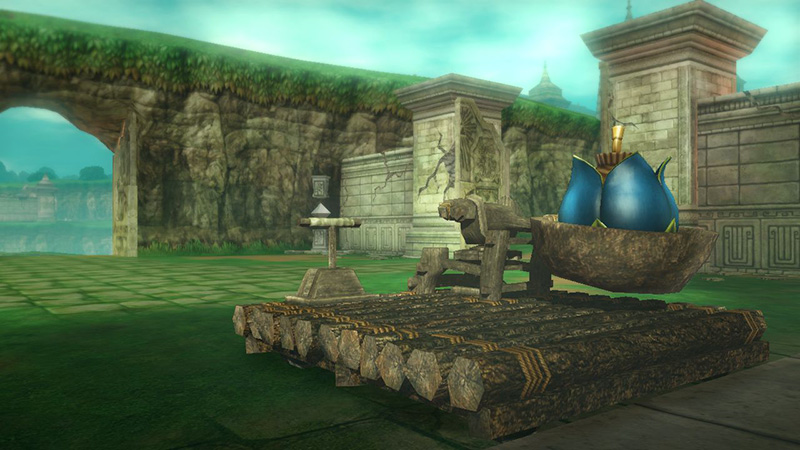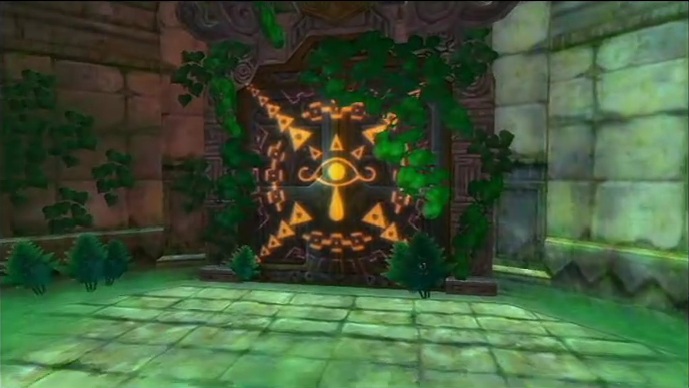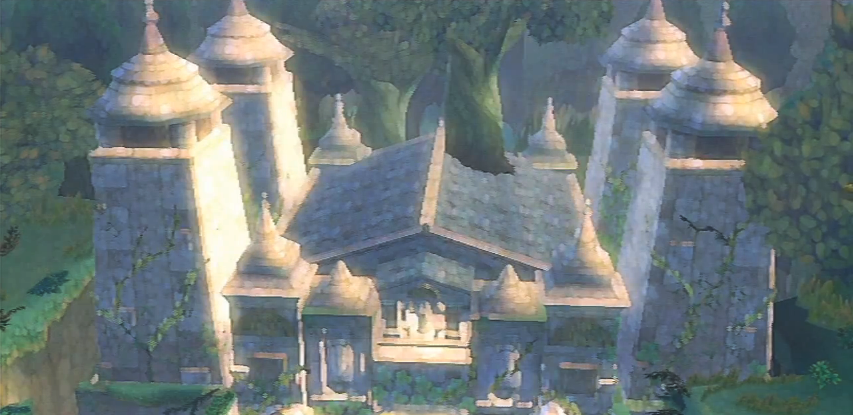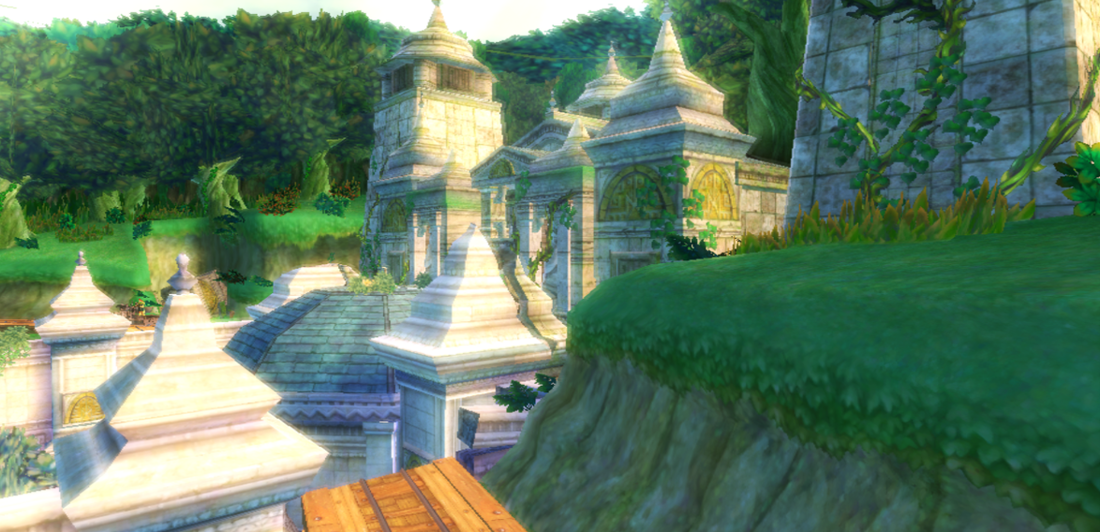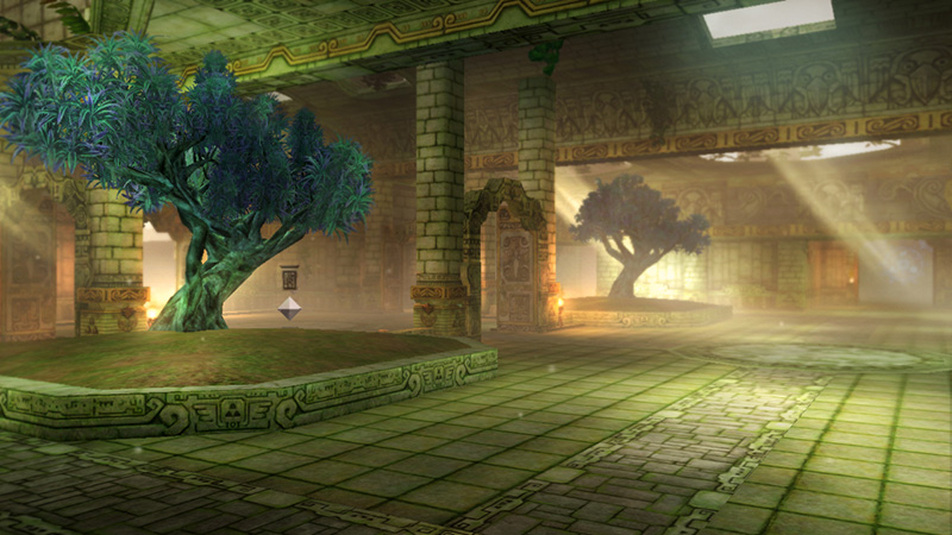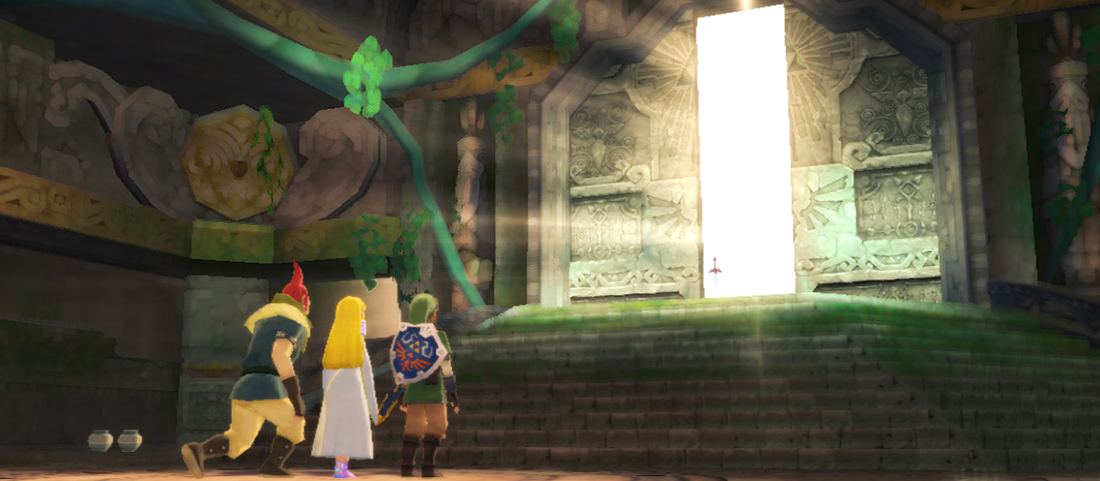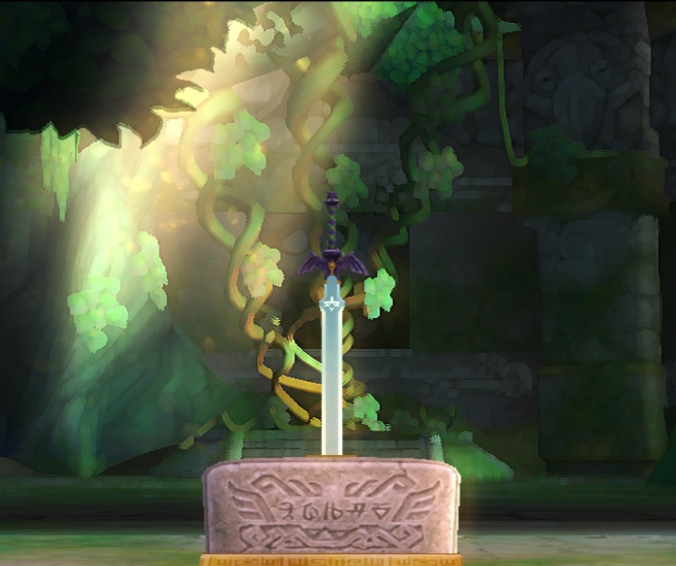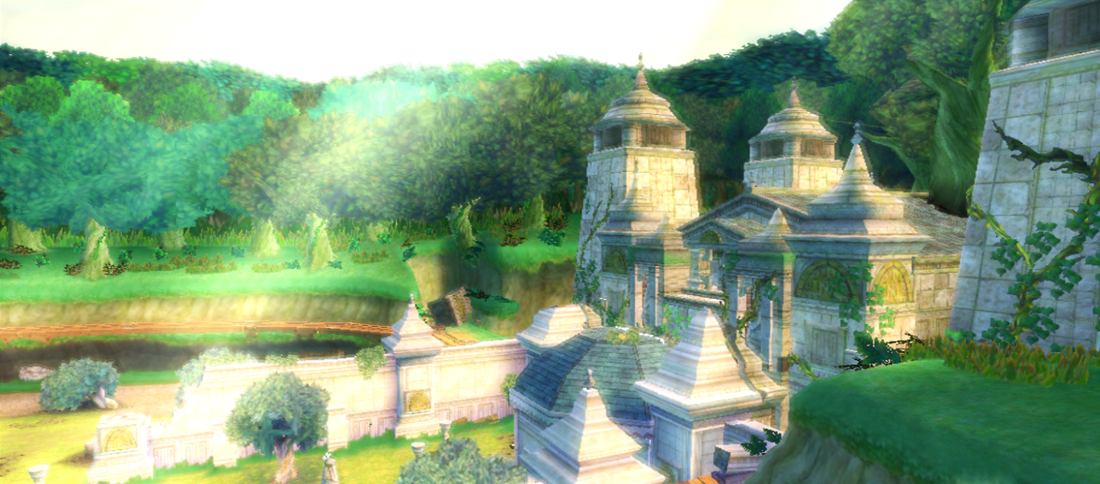The Sealed Grounds and Intentions of the Goddess
“An ancient forest remains here, seemingly preserved in time . . . This place is called the Sealed Temple. Judging by the extent of structural degradation, I project that it has stood here for a very long time. Due to its solid stone construction, the air inside is relatively cool. There is also an unquantifiable mystery to this place.”
— Fi, Skyward Sword
— Fi, Skyward Sword
Picture Credit: 女神の牢獄 by 星丸
As Link descends from the brilliant vibrancy of life above the clouds to the more subdued land thereunder, we should try our very best to imagine the sheer confusion and overwhelming awe that he must feel. After all, he has never lived with anything but the azure sky above his head, and now he is below what was always far under his feet. Through such shifts in perspective, we can begin to understand, or at least empathize with, the disorienting nature of such a shift in viewpoint. Aside from this initial disorientation, however, something stranger is evidenced through the ruins that dot this land — previous peoples and civilizations have lived countless generations on the Surface, and those above the clouds have lost all knowledge of this. Link and Zelda are acting, through the machinations of Fate, as the primary explorers and emissaries of Skyloft, surveying a land thought only to exist in legend. And, what is more, they are doing so while simultaneously attempting to discover their individual roles within the designs laid down by the goddess so many years ago. Placing such overwhelming burdens upon two youths was likely not a choice made easily, but this was the plan devised by the goddess Hylia. And, if we are ever to understand the chosen hero, we must realize the deep and powerful changes forced upon him by these events.
Falling from the heavens, Link would find the air beginning to get denser and denser as he traveled through cloud and fog. Breaking the cloud-line, a hazy world of muted greens and greys would slowly become visible. Landing beside a deep, downward-spiraling pit, the half-formed ruins of a once majestic temple would grow clearer in the midday sun. These are the Sealed Grounds, though Link does not yet know this, and they play an essential function in revealing of the strands of Fate.
Falling from the heavens, Link would find the air beginning to get denser and denser as he traveled through cloud and fog. Breaking the cloud-line, a hazy world of muted greens and greys would slowly become visible. Landing beside a deep, downward-spiraling pit, the half-formed ruins of a once majestic temple would grow clearer in the midday sun. These are the Sealed Grounds, though Link does not yet know this, and they play an essential function in revealing of the strands of Fate.
There are several physical aspects to this location. The most prominent feature of this landscape is, of course, the massive opening that begins almost immediately in front of the temple gate. As we know, the spiraling path leading to the bottom of the pit is a perfect mirror of the dirt and rock beneath the Statue of the Goddess high above in Skyloft. When Skyloft ascended to the heavens, a scar was left upon the face of the land. A path of stone winds around the outer edge of the chasm, encircling it in its entirety at the surface level, and another extends to its uttermost bottom. On this latter road, concentrated jets of air periodically, rhythmically rise from the earth, sending dust, as well as unwary passengers, into the air. As one travels deeper, familiar pictures can be seen upon the dirt walls of the gorge; these pictures are the exact pictures seen in the prologue — the prehistoric cave paintings of ages forgotten. The story of what happened to the land is etched upon the land itself. The provenance of these paintings is, as with most things, unknown to us, but we can still put forth a few guesses. There were several sentient species left upon the surface after Hylia moved earth to heaven, and it may have been any one of these. However, only one species is known to have a tradition of painting, and this is the Goron people. Paintings are evidenced in nearly all of their communities, though this is only a tentative connection. Eventually, this path levels off, culminating in a circular sward into which is embedded a black thorn. Upon this instrument are the three symbols of the Golden Goddesses, with a host of other arcane markings. This is referred to as the Sealing Spike, and it serves as a barrier against the Imprisoned — a monstrous avatar of Demise. As these storied events unfold, Link will visit the Sealed Grounds many times, as the seal upon Demise grows progressively weaker and threatens to break.
As in many legends, this tale is ultimately concerned with the forces of Light and Darkness. Demise, King of Demons, for reasons unknown to us (perhaps it is simply his nature) wishes to control all that exists, breaking and twisting all life to his will. And, as so often happens, this great evil is checked by a force that is perhaps not equal to it in power, but which is greater in foresight, in sacrifice, and in love.
When the Three Golden Goddesses departed this world after its creation at the beginning of existence, they imparted knowledge of the Triforce to the goddess Hylia, and charged her with its protection. In her hands, no evil came to mar its surface, and for an entire era she kept it. Witnessing the might of Demise, and realizing that she lacked the power to stop him, she gathered her chosen people upon an outcrop of earth and sent them skyward. After separating herself from those who held her most dear, she created a massive wall of clouds to separate earth and sky. Satisfied with the strength of her barriers, and believing her people protected, she joined the Five Tribes of the surface into a single force which finally defeated the demon hordes of Demise. After this protracted battle and the eventual sealing of Demise, Hylia knew herself to be gravely wounded. She realized that if Demise were to break his seal and once more threaten the land, she would be powerless to stop him. And more so, she knew that this Seal upon Demise would not long hold against the Demon King’s power. Above all, she seemed to wish for the well-being and wholeness of the entire world, and all in it, and so she devised two plans and set them both into motion.
As in many legends, this tale is ultimately concerned with the forces of Light and Darkness. Demise, King of Demons, for reasons unknown to us (perhaps it is simply his nature) wishes to control all that exists, breaking and twisting all life to his will. And, as so often happens, this great evil is checked by a force that is perhaps not equal to it in power, but which is greater in foresight, in sacrifice, and in love.
When the Three Golden Goddesses departed this world after its creation at the beginning of existence, they imparted knowledge of the Triforce to the goddess Hylia, and charged her with its protection. In her hands, no evil came to mar its surface, and for an entire era she kept it. Witnessing the might of Demise, and realizing that she lacked the power to stop him, she gathered her chosen people upon an outcrop of earth and sent them skyward. After separating herself from those who held her most dear, she created a massive wall of clouds to separate earth and sky. Satisfied with the strength of her barriers, and believing her people protected, she joined the Five Tribes of the surface into a single force which finally defeated the demon hordes of Demise. After this protracted battle and the eventual sealing of Demise, Hylia knew herself to be gravely wounded. She realized that if Demise were to break his seal and once more threaten the land, she would be powerless to stop him. And more so, she knew that this Seal upon Demise would not long hold against the Demon King’s power. Above all, she seemed to wish for the well-being and wholeness of the entire world, and all in it, and so she devised two plans and set them both into motion.
First, she created Fi. And this spirit, held within the Goddess Sword, had but one function: to assist the chosen hero on his mission. Her second plan was to abandon her divine form and transfer her soul into the body of a mortal. She made this sacrifice in the hope that, in the distant future, the chosen hero, guided by her awakened form, could use the power of the old gods to defeat evil forever. As is known to us, though the Triforce was created by divinity, it cannot not by divinity be used. Thus, a human agent is necessary.
No less critical in her plans were the Trials of the Hero. Having witnessed the awesome power of Demise firsthand, she knew that her chosen hero would one day need to be capable of wielding tremendous power to defeat the embodiment of all malevolence. To this end she created several trials to serve as a way of honing the nascent skills of her hero. And knowing that the young hero would doubtlessly need guidance on his journey, she imparted knowledge of her designs to the great spirits of the world, giving each an aspect of her plan as they guarded over the land in her stead.
Fi is fascinating. Though she is but a cog in the grand schemes of her creator, she presents a storyline that is as beautiful as it is morally perplexing. Fi is, put most simply, a program. She was fashioned for a singular function, and she completes it without questioning its motives, reasoning, or consequences. A perfect servant, she knows neither choice nor response, save for that which was given to her by her coding. It is through Fi that Hylia moves the flow of destiny, and without Fi there would be no end to that which is predestined.
This spirit of the sword serves as a messenger of the gods and as the unfailing companion of the hero. It is she who wakes the hero within Link, and she that helps him through his trials. As Link progresses through his tribulations, her programming continues along preset lines to match whatever objective has been triggered deep within her. Everything is predetermined, and, like clockwork, it proceeds unfailingly. Most interesting in her development, though, is the end scene of the game, in which she admits to having feelings of what she believes to be happiness. Wait! we say. She is but a program, unconscious of all that moves her in this tale! How can she possibly feel such an emotion? I believe that, as with all else, this feeling is but a part of her programming — a reward, perhaps, from her creator. As she advances along the inescapable path of her programming, it may be that she begins to develop a slight capability for emotion. It is my assumption that Hylia, who has a nearly transcendent capacity for compassion, would have felt guilt at her creation of a being that lacked any notion of free will. And so she would have given Fi a taste of humanity — a sample of emotion felt by those that Hylia loved above all others — before her entombment within the Master Sword.
No less critical in her plans were the Trials of the Hero. Having witnessed the awesome power of Demise firsthand, she knew that her chosen hero would one day need to be capable of wielding tremendous power to defeat the embodiment of all malevolence. To this end she created several trials to serve as a way of honing the nascent skills of her hero. And knowing that the young hero would doubtlessly need guidance on his journey, she imparted knowledge of her designs to the great spirits of the world, giving each an aspect of her plan as they guarded over the land in her stead.
Fi is fascinating. Though she is but a cog in the grand schemes of her creator, she presents a storyline that is as beautiful as it is morally perplexing. Fi is, put most simply, a program. She was fashioned for a singular function, and she completes it without questioning its motives, reasoning, or consequences. A perfect servant, she knows neither choice nor response, save for that which was given to her by her coding. It is through Fi that Hylia moves the flow of destiny, and without Fi there would be no end to that which is predestined.
This spirit of the sword serves as a messenger of the gods and as the unfailing companion of the hero. It is she who wakes the hero within Link, and she that helps him through his trials. As Link progresses through his tribulations, her programming continues along preset lines to match whatever objective has been triggered deep within her. Everything is predetermined, and, like clockwork, it proceeds unfailingly. Most interesting in her development, though, is the end scene of the game, in which she admits to having feelings of what she believes to be happiness. Wait! we say. She is but a program, unconscious of all that moves her in this tale! How can she possibly feel such an emotion? I believe that, as with all else, this feeling is but a part of her programming — a reward, perhaps, from her creator. As she advances along the inescapable path of her programming, it may be that she begins to develop a slight capability for emotion. It is my assumption that Hylia, who has a nearly transcendent capacity for compassion, would have felt guilt at her creation of a being that lacked any notion of free will. And so she would have given Fi a taste of humanity — a sample of emotion felt by those that Hylia loved above all others — before her entombment within the Master Sword.
Fi’s final, melancholy words to Link are these: “Link, hear me. My purpose was to obey the command of the goddess and lead you, the chosen hero of this land, on your quest. When I first awoke and began this task, I perceived it as merely serving my function as a servant to Her Grace. However, I have come to consider the information corresponding to our time together among the most precious data I have on record. I do not have the capability to fully understand the human spirit, Link . . . But now, at the end of my journey with you, as I prepare to sleep within the Master Sword forever, I experience a feeling I am unable to identify. I lack sufficient data to be sure of my conclusion, but I believe this feeling correlates closest to what your people call . . . happiness. Our partnership is at an end, and even as we speak, I feel my consciousness fading away. Before I enter the sleep that calls me to the sword, I wish to relay to you words that I recorded many times over the course of our journey. Many have said them to you thus far, but I now wish to say them for myself. Thank you, Master Link. May we meet again in another life . . . .” Though she is often slandered as a companion character, I believe that Fi has a story and charm unique to her, and one that has not been approached in any game before. To blame her for her lack of personality, or for her mechanical precision or terse mannerisms, is ridiculous. She was not created with those functions in mind, and so such things are quite literally impossible. They exist outside her programming.
Overall, with this above exposition I hope to accomplish but one thing, and that is to establish some of the reasons and history behind the deification and worship of the goddess Hylia. It is not for nothing that she has been worshipped so faithfully across the ages. Her sacrifice, foresight, and compassion all denote an intense intelligence, a fierce protectiveness, and an uncanny wisdom. Her empathy and consideration spread even to those beings that were not alive in a technical sense, and this sets Hylia apart from many common human conceptualizations of deities. Ultimately, Hylia sacrificed her divinity for the benefit of the world.
Overall, with this above exposition I hope to accomplish but one thing, and that is to establish some of the reasons and history behind the deification and worship of the goddess Hylia. It is not for nothing that she has been worshipped so faithfully across the ages. Her sacrifice, foresight, and compassion all denote an intense intelligence, a fierce protectiveness, and an uncanny wisdom. Her empathy and consideration spread even to those beings that were not alive in a technical sense, and this sets Hylia apart from many common human conceptualizations of deities. Ultimately, Hylia sacrificed her divinity for the benefit of the world.
As Link makes his way back to the temple façade, passing by the fallen columns and ruins of the Sealed Grounds, the most noticeable aspect of the temple front is the orange symbol of the Sheikah acting as a lock upon the door. We cannot say how long this seal has been in place, but it was likely put in place by Impa to further protect the sanctity of this structure. As Link arrives, however, the seal is broken, and the gears of Fate continue to move. When Hylia raised Skyloft, the antechamber in which Link now stands was broken in two, carrying away with it a large portion of the temple exterior in the process. The dome that rests above the main doorway has been half-destroyed, but several elemental medallions, along with part of the Triforce, can still be seen clearly. As the stone can clearly be seen through the images, it is likely that these symbols were painted on using gold and blue paint, which, remarkably, has yet to fade. Much of the temple facing the pit is now ruined, and is covered with ivy and faded by years of weathering. Structurally speaking, the temple is basically symmetrical, with four corner towers, a rectangular hall, and aligned perfectly from one end to the other. The slope and shape of the roof hint at possible Greek-inspired origins, but the towers and domes that grace the structure are not of the same tradition, and this is where the similarities end. Aside from the façade, upon which are located several enshrined statues of Loftwings and the goddess Hylia, there are no overt symbols of worship on the exterior of the building, and the grey stone of which it is constructed is virtually blank. The diminutive statue of Hylia stands beneath a small Greek temple front, and this miniature hall is flanked by two smaller structures under which rest a set of Loftwings. Upon the pediment above the goddess statue is a semicircular design of gold, which may reflect the fragmented dome resting at the feet of the statue. Concerning the masonry, those stones which comprise the wall are simply cut, and were likely placed without a form of mortar. The joints between the stones are very thin, and the visible face of the stone looks as though it might once have been highly polished. To me, both of these aforementioned facts seem to hint at the use of ashlar masonry — a style of masonry in which each individual stone is cut with demanding precision, so that the blocks fit perfectly against one another.
The impressionistic art style of this game is magnificently portrayed within the temple. From the initial clarity of the surrounding pillars just inside the doorway, the far end of the room becomes obfuscated, almost to the point where one can solely see the intermingling of various colors. Greys and greens in the periphery meet with the bright gold of a strong sunbeam, and this scene, as it is framed by these rows of pillars, almost appears as a large panel of stained glass. Stained glass has primarily religious undertones, and this impressionistic stillness reinforces the sanctity of this place. The Sealed Temple (which was formerly the Temple of Hylia) stands as age embodied. Its antiquity is beyond recall, and it will go on to obtain new life as the Temple of Time, constructed by the inimitable Sage, Rauru, in a later epoch.
It is evident that this temple has not housed anything for many years. The inside is predominantly barren, and, aside from an altar, staircase, bird statue, pedestal, and tree, contains precious little. The altar stands central between eight solid pillars, coated with years of ivy and lichen. There are several motifs at work here, and all of them stand in great contrast to the stonework of the structure itself; whereas the outside was a highly-organized system of blocks in straight lines, the stonework of the inside, in some places, is much more artistic. In contrast to this standard, grey-stone masonry, the embellishments and themes herein stand out as pristine. The first embellishment can be seen above each of the smaller doorways and at the tops of the larger columns found in each corner of the room. A shield of gold, or perhaps a medallion, is the centerpiece of each door frame, and is decorated with an image of what appears to be the four winds — each confined to a separate quadrant of the marker, surrounding a central node. The lintel, replicated for each door, is purely decorative, and appears to be only loosely attached to each fixture. As with much decorative stonework within these more ancient temples, the craftsmanship is spectacular; the reason for the blockiness, or semi-angularity — even with fluid designs, is likely due to the tools available in these earlier eras. As with all technologies, these tools would have had to evolve from simplicity to complexity. This aged structure is among the earliest we know of, and the craftsmanship seems to reflect this. Only in later ages of Hyrule do we see the knowledge and skill necessary to create things like the statuary group above the throne of Hyrule in Twilight Princess, with its graceful fluidity and lightness of appearance.
In layout, only a few rooms are known to us. The central hall, which is comprised of a nave and aisles, both of which terminate before the staircase, is the main chamber, and is the most ornate. The large pillars, central altar, and staircase are the main features of this room, and the design elements we see upon the walls, ceiling, and piers are those found beneath the Statue of the Goddess that resides in Skyloft. And, as these two buildings were once the same structure, this should not be surprising. The Triforce motif carries on here, some of them strangely inverted (something we very rarely, rarely ever see), as well as the Loftwing design which appears in intervals upon the stone beams of the ceiling. Two other closely-related themes are also present — an image of the goddess, and the Goddess harp. All of these images are inextricably tied to one another, and represent much of the religious symbolism surrounding Hylia. These are, in fact, religious signs, and represent a connection to the divine. Where they appear, divinity must therein reside.
It is evident that this temple has not housed anything for many years. The inside is predominantly barren, and, aside from an altar, staircase, bird statue, pedestal, and tree, contains precious little. The altar stands central between eight solid pillars, coated with years of ivy and lichen. There are several motifs at work here, and all of them stand in great contrast to the stonework of the structure itself; whereas the outside was a highly-organized system of blocks in straight lines, the stonework of the inside, in some places, is much more artistic. In contrast to this standard, grey-stone masonry, the embellishments and themes herein stand out as pristine. The first embellishment can be seen above each of the smaller doorways and at the tops of the larger columns found in each corner of the room. A shield of gold, or perhaps a medallion, is the centerpiece of each door frame, and is decorated with an image of what appears to be the four winds — each confined to a separate quadrant of the marker, surrounding a central node. The lintel, replicated for each door, is purely decorative, and appears to be only loosely attached to each fixture. As with much decorative stonework within these more ancient temples, the craftsmanship is spectacular; the reason for the blockiness, or semi-angularity — even with fluid designs, is likely due to the tools available in these earlier eras. As with all technologies, these tools would have had to evolve from simplicity to complexity. This aged structure is among the earliest we know of, and the craftsmanship seems to reflect this. Only in later ages of Hyrule do we see the knowledge and skill necessary to create things like the statuary group above the throne of Hyrule in Twilight Princess, with its graceful fluidity and lightness of appearance.
In layout, only a few rooms are known to us. The central hall, which is comprised of a nave and aisles, both of which terminate before the staircase, is the main chamber, and is the most ornate. The large pillars, central altar, and staircase are the main features of this room, and the design elements we see upon the walls, ceiling, and piers are those found beneath the Statue of the Goddess that resides in Skyloft. And, as these two buildings were once the same structure, this should not be surprising. The Triforce motif carries on here, some of them strangely inverted (something we very rarely, rarely ever see), as well as the Loftwing design which appears in intervals upon the stone beams of the ceiling. Two other closely-related themes are also present — an image of the goddess, and the Goddess harp. All of these images are inextricably tied to one another, and represent much of the religious symbolism surrounding Hylia. These are, in fact, religious signs, and represent a connection to the divine. Where they appear, divinity must therein reside.
A small chapel connects to the main hall, and houses a raised platform upon which a tree grows. A delicate stained glass window rests within the stonework of the dome, and casts varicolored light upon the still branches below. A carpet of grass rests quietly upon the floor, though it does not stretch to the main hall. The final sanctum is very similar in environment to this smaller chapel. Large branches and limbs grow through the walls of the circular chamber, and much of the room lies in disarray. The roof has been damaged greatly, and several of the pilasters (which are crowned with the Loftwing motif described earlier) are fragmented badly.
The final unexplored doorway leads outside. This gently sloped pathway, which connects to the ancient Faron Woods, is bright with sunlight, open, and quiet. It is rare in Zelda games to have these strange pockets of silence, in which one can only hear the ambient sounds of nature, but this area directly outside this part of the Sealed Temple is one of them. Perhaps this is meant to signify the nearness of nature, and the centrality of the woods to the upcoming chapter of the legend. Whatever it represents, however, it is a welcome oasis of stillness in the days when the woods were yet young.
The final unexplored doorway leads outside. This gently sloped pathway, which connects to the ancient Faron Woods, is bright with sunlight, open, and quiet. It is rare in Zelda games to have these strange pockets of silence, in which one can only hear the ambient sounds of nature, but this area directly outside this part of the Sealed Temple is one of them. Perhaps this is meant to signify the nearness of nature, and the centrality of the woods to the upcoming chapter of the legend. Whatever it represents, however, it is a welcome oasis of stillness in the days when the woods were yet young.

